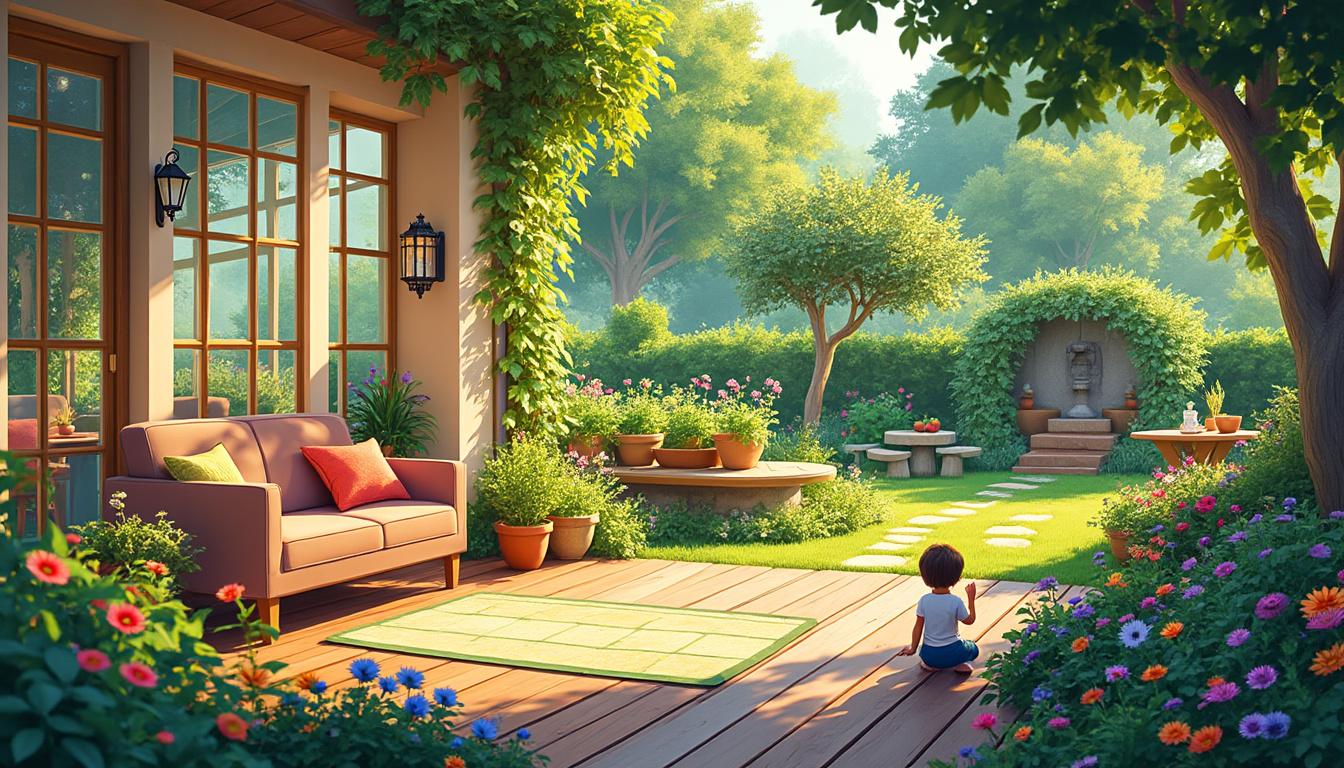Exploring the multifaceted domains of home, garden, and outdoor spaces unlocks a world of design possibilities, lifestyle enhancements, and sustainable living practices. Each space, while distinct, shares a dynamic interplay that can boost wellness, functionality, and aesthetic appeal. As homeowners increasingly seek to blur the boundaries between interiors and exteriors, understanding how these realms connect is essential. Whether embracing the sleek selections from IKEA and Wayfair or integrating nature through the premium offerings of Gardener’s Supply Company, opportunities abound to transform everyday living into an immersive experience.
Optimizing Indoor Spaces Through Strategic Design and HomeGoods Selections
Indoor environments form the foundation of comfort and personal expression. Creating a home that aligns with daily routines and leisure desires optimizes well-being and efficiency. Leveraging resources like HomeGoods and West Elm enables homeowners to source pieces that combine style and practicality without compromising budget. Customizing areas through furniture arrangement, lighting schemes, and color palettes enhances spatial flow and ambiance.
Understanding the spatial layout is paramount when updating interiors. For example, integrating multifunctional furniture can maximize limited rooms. Products from Pottery Barn, known for craftsmanship and timeless design, offer classic yet adaptable solutions perfect for living rooms, bedrooms, or dining areas. Coupled with natural lighting optimization and smart storage solutions often showcased at Lowe’s and The Home Depot, these elements coagulate into inviting, clutter-free interiors.
Effective Lighting Strategies for Enhanced Comfort and Productivity
Lighting plays a vital role in indoor spaces, influencing mood, aesthetics, and activity. Layered lighting—combining ambient, task, and accent sources—creates versatility. Incorporating dimmable fixtures allows for customization depending on time of day or activity. For instance, a workspace might benefit from bright LED task lights from Crate & Barrel, while a relaxation nook thrives under softer, warm accents.
- Ambient lighting – Overhead fixtures, chandeliers, or recessed lighting to create general illumination.
- Task lighting – Adjustable lamps for reading, cooking, or hobbies, enhancing focus and reducing eye strain.
- Accent lighting – Highlights architectural features or artworks, adding depth and visual interest.
Investing in energy-efficient bulbs and smart lighting systems further elevates indoor environments. Practical design aligned with energy consciousness supports comfort while reducing utility expenses.
Incorporating Sustainable Materials for a Health-Conscious Home
With evolving trends emphasizing sustainability, selecting home goods that minimize environmental impact is critical. West Elm provides a variety of eco-friendly furnishings, crafted from responsibly sourced woods and recycled materials. Such choices not only reduce a property’s carbon footprint but also contribute to healthier indoor air quality. The use of natural fibers in textiles—organic cotton, wool, or hemp—further imbues interiors with warmth and durability.
| Material | Benefits | Common Uses | Retailers |
|---|---|---|---|
| Reclaimed Wood | Reduces deforestation, adds rustic character | Furniture, flooring, shelving | West Elm, Pottery Barn |
| Organic Cotton | Free from harmful pesticides, soft texture | Upholstery, curtains, bedding | HomeGoods, IKEA |
| Bamboo | Rapidly renewable, moisture-resistant | Flooring, blinds, furniture accents | Wayfair, The Home Depot |
Transforming Gardens Into Sustainable Sanctuaries with Gardener’s Supply Company Resources
Modern garden design transcends mere planting; it incorporates ecological balance, functionality, and aesthetic pleasure. Gardener’s Supply Company offers a wide range of tools, structures, and organic solutions enabling gardeners to nurture vibrant ecosystems. Incorporating drought-resistant plants, rainwater harvesting systems, and pollinator gardens fosters biodiversity while reducing water use.
Successful gardening begins with soil health. Utilizing organic compost and natural pest control supports plant vitality without environmental harm. For example, introducing beneficial insects such as ladybugs or employing barrier methods reduces reliance on chemical pesticides. Exploring resources like ants helping peonies flourish highlights natural interactions that enhance garden growth effectively.
Integrating Seasonal Planting for Year-Round Visual and Ecological Interest
Strategically planning plantings to ensure blooms, fruits, or foliage throughout all four seasons enriches garden appeal. Early spring bulbs, summer perennials, fall shrubs with colorful leaves, and evergreens maintain continuous interest. Winter gardening bliss is also attainable by selecting hardy species and protective measures, as extensively discussed in seasonal gardening guides.
- Spring: Tulips, daffodils, ornamental onions
- Summer: Lavender, echinacea, sunflowers
- Fall: Chrysanthemums, asters, ornamental kale
- Winter: Holly, winterberry, evergreen shrubs
Complementing flora diversity with garden infrastructure—raised beds, trellises, or benches from Gardener’s Supply Company—creates functional and inviting spaces that encourage outdoor enjoyment and relaxation.
Water Management Practices to Preserve Garden Health
Efficient use of water resources is crucial to sustainable garden upkeep. Installing drip irrigation, mulching to reduce evaporation, and harvesting rainwater reduce overall consumption. The Home Depot and Lowe’s provide numerous products that facilitate these practices with convenience and reliability.
| Water Management Technique | Advantages | Recommended Retailers |
|---|---|---|
| Drip Irrigation Systems | Targets plant roots, reduces water waste | Lowe’s, The Home Depot |
| Mulching | Moisture retention, weed suppression | Gardener’s Supply Company, HomeGoods |
| Rainwater Harvesting | Reduces municipal water dependence | Gardener’s Supply Company |
Designing Outdoor Living Spaces That Blend Comfort With Nature’s Aesthetic
Outdoor spaces have evolved from simple yards to functional extensions of the home. Creating outdoor living rooms, kitchens, or lounges reflects modern preferences for entertaining and relaxing amid natural surroundings. Leading brands like Crate & Barrel and West Elm offer stylish, weather-resistant furnishings to elevate these environments.
A harmonious outdoor setup balances durability with aesthetics. Materials such as teak, synthetic wicker, and powder-coated metals blend style with resilience against the elements. Coordinating color schemes and soft textiles add layers of comfort, while lighting—solar and LED—extends usability into the evening.
Key Considerations for Outdoor Furniture and Layout Planning
Planning an outdoor space requires attention to scale, traffic flow, and function. Delineating zones—dining, seating, cooking—optimizes usage and comfort. For example, placing seating to overlook shaded garden spots leverages natural ambiance. Modular furniture allows flexible arrangements adapting to different occasions.
- Durability: Resistance to moisture, UV rays, and temperature changes
- Comfort: Cushion quality and fabric breathability
- Maintenance: Ease of cleaning and weatherproofing
- Style: Cohesion with home and garden design themes
Seasonal transformations can refresh outdoor spaces. Swapping fabrics or adding decorative pillows from Wayfair or IKEA provides cost-effective updates that maintain interest throughout the year.
Enhancing Outdoor Experiences with Smart Technologies
Smart outdoor technologies elevate enjoyment and management of gardens and patios. Automated irrigation systems linked to weather data optimize watering schedules, conserving resources. Outdoor speakers and lighting controlled via mobile apps contribute to ambiance and security. These innovations, increasingly accessible at The Home Depot and Lowe’s, underscore trends toward convenience and integration.
Strategies for Seamless Indoor-Outdoor Connectivity Using Products from IKEA and Pottery Barn
Bridging indoor and outdoor environments fosters spaciousness and offers continuous sensory experiences. IKEA promotes multi-functional furnishings that transition easily between inside and outdoor use, while Pottery Barn accentuates timeless pieces that endure weather conditions elegantly.
Key design principles include aligning flooring materials, coordinating color palettes, and employing sliding glass doors or large windows to merge visibility and accessibility. This integration encourages natural light flow, ventilates interiors, and visually expands living areas.
Designing Transitional Zones That Support Flexibility and Cohesion
Transitional zones, such as covered patios or sunrooms, serve as buffers and connectors. They enable lifestyle versatility, accommodating shifts from indoor relaxation to alfresco dining effortlessly. Including planters, rugs, and decorative items consistent with interior themes enhances unity.
- Flooring: Use weather-resistant decking materials matching indoor finishes
- Furniture: Select multi-seasonal pieces suitable for both realms
- Colors: Extend indoor color schemes into outdoor components
- Accessories: Incorporate durable textiles and nature-inspired decor
For inspiration, the Central Ohio Home & Garden Show showcases many seamless integration ideas employing recognized brands, making it a valuable resource for homeowners (Central Ohio Home & Garden Show).
Safety and Maintenance Essentials for Harmonious Home, Garden, and Outdoor Spaces
Ensuring the safety and longevity of home and outdoor realms necessitates vigilant maintenance and mindful practices. Pest control, secure installations, and compliance with local regulations protect investments and inhabitant well-being. The Home Depot offers expert advice and comprehensive product lines for garden pest management and home care solutions.
Effective Pest Control Strategies That Protect Gardens and Homes
Pests threaten plant health and structural integrity. Implementing integrated pest management (IPM) techniques reduces chemical dependency while maintaining control. Employing traps, beneficial insects, and natural repellents produces balanced results. For challenging infestations, consult trusted resources such as rat control strategies for guidance on maintaining a secure environment.
- Physical Barriers: Fencing and plant covers to block entry
- Biological Controls: Introducing predator species like ladybugs
- Natural Repellents: Use of garlic sprays or neem oil
- Regular Monitoring: Early detection to prevent escalation
Regular inspection and prompt intervention minimize damage and maintain garden vitality, enhancing the overall enjoyment of outdoor spaces.
Grilling and Outdoor Food Safety for Social Gatherings
Outdoor cooking is integral to garden entertaining but carries food safety risks if improperly managed. The USDA food safety guidelines for grilling, available through reputable sources such as USDA Food Safety Grilling, offer emphases on cooking temperatures, hygiene, and food storage. Ensuring clean utensils, preventing cross-contamination, and selecting safe cooking fuels contribute to health-secure get-togethers.
| Food Type | Safe Internal Temperature (°F) | Recommended Cooking Practices |
|---|---|---|
| Beef, Pork, Lamb (Steaks, Chops, Roasts) | 145 with 3-minute rest | Use a food thermometer, avoid cross-contamination |
| Ground Meats (Beef, Pork, Lamb) | 160 | Cook thoroughly, separate raw and cooked foods |
| Poultry (Whole, parts, ground) | 165 | Use clean utensils, handle thawed meats safely |
Adopting these practices ensures memorable and safe outdoor dining experiences that complement well-designed garden and patio spaces.
Frequently Asked Questions About Home, Garden, and Outdoor Enhancements
- How can I effectively blend indoor and outdoor living spaces?
Achieving a seamless transition involves consistent color palettes, coordinated materials, and architectural elements like sliding glass doors. Incorporate multi-functional furniture suitable for weather variations and design buffer zones such as covered patios. - What sustainable gardening practices can I adopt?
Utilize drought-resistant plants, organic compost, rainwater harvesting systems, and biological pest control. Prioritize native species and seasonal plantings to maintain local ecology and reduce maintenance. - Which retailers offer durable and stylish outdoor furniture?
Brands including Crate & Barrel, West Elm, and Wayfair provide durable, weather-resistant furniture with fashionable designs that withstand outdoor elements. - What are some essential safety tips for outdoor cooking?
Follow USDA-recommended temperatures, maintain hygiene, avoid cross-contamination, and carefully select cooking fuels. Regularly clean grills and handle food storage correctly to prevent foodborne illnesses. - How to manage pests naturally in garden and home environments?
Integrate physical barriers, introduce beneficial insects, use natural repellents like neem oil, and monitor regularly to detect early infestations, minimizing chemical usage.

